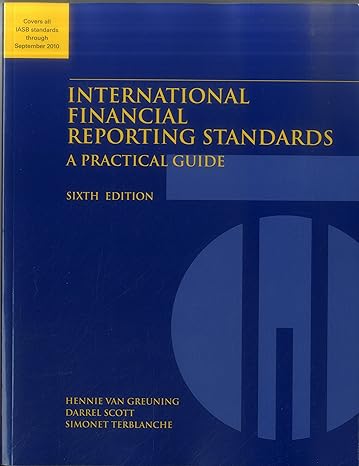Question
----DIVIDEND POLICY---- Mr. John Green has established the CBB company which produces small vehicles 10 years ago. As a sole owner of all shares of
----DIVIDEND POLICY----
Mr. John Green has established the CBB company which produces small vehicles 10 years ago. As a sole owner of all shares of the company, Mr. Green has decided to take the company public to achieve the growth targets of his company. At present, the company has a capital structure of 60 percent equity and 40 percent debt. Before talking to potential outside investors, Mr. Green want to decide on a dividend policy. Assume that you were hired to help the CBB prepare for its public offering and to make a presentation to Mr. Green on the theory of dividend policy and discuss the following question.
a. 1. What is meant by the term distribution (dividend) policy?
a. 2. The terms irrelevance, bird in hand, and tax preference have been used to describe three major theories regarding the way dividend payouts affect a firms value. Explain what these terms mean, and briefly describle each theory.
a. 3. What does the threee theories indicate regarding the actions management should take with respect to dividend payout?
b. Discuss (1) the information content, or signaling, hypothesis, (2) the clientele effect, and (3) their effects on distribution policy.
c. 1. Assume that CBB has an $800.000 capital structure planned for the coming year. You have determined that its present capital structure (60 percent equtiy and 40 percent debt) is optimal, and its net income is forecasted at $600.000. Use the residual distribution model approach to determine CBBs total dolar distribution. Assume for now that the distribution is in the form of a dividend. Then explain what would happen if net income were forecasted at $400.000, or at $800.000.
c. 2. What are the advantages and disadvantages of the residual policy? (Hint: dont neglect signalling and clientele effects).
d. What are stock repurchases? Discuss the advantages and disadvantages of a firms repurchasing its own shares.
e. Describe the series of steps that most firms take in setting dividend policy in practice.
f. What stock dividends and stock splits? What are the advantages and disadvantages of stock dividends and stock splits?
g. What is a dividend reinvestmant plan (drip), and how does it work?
Step by Step Solution
There are 3 Steps involved in it
Step: 1

Get Instant Access to Expert-Tailored Solutions
See step-by-step solutions with expert insights and AI powered tools for academic success
Step: 2

Step: 3

Ace Your Homework with AI
Get the answers you need in no time with our AI-driven, step-by-step assistance
Get Started


